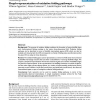Free Online Productivity Tools
i2Speak
i2Symbol
i2OCR
iTex2Img
iWeb2Print
iWeb2Shot
i2Type
iPdf2Split
iPdf2Merge
i2Bopomofo
i2Arabic
i2Style
i2Image
i2PDF
iLatex2Rtf
Sci2ools
BMCBI
2005
2005
Graph-representation of oxidative folding pathways
Background: The process of oxidative folding combines the formation of native disulfide bond with conformational folding resulting in the native three-dimensional fold. Oxidative folding pathways can be described in terms of disulfide intermediate species (DIS) which can also be isolated and characterized. Each DIS corresponds to a family of folding states (conformations) that the given DIS can adopt in three dimensions. Results: The oxidative folding space can be represented as a network of DIS states interconnected by disulfide interchange reactions that can either create/abolish or rearrange disulfide bridges. We propose a simple 3D representation wherein the states having the same number of disulfide bridges are placed on separate planes. In this representation, the shuffling transitions are within the planes, and the redox edges connect adjacent planes. In a number of experimentally studied cases (bovine pancreatic trypsin inhibitor, insulin-like growth factor and epidermal growt...
| Added | 15 Dec 2010 |
| Updated | 15 Dec 2010 |
| Type | Journal |
| Year | 2005 |
| Where | BMCBI |
| Authors | Vilmos Ágoston, Masa Cemazar, László Kaján, Sándor Pongor |
Comments (0)

